Definition of demand-side platform
Demand Side Platform (or DSP for short) is an online software which allows any advertiser or advertising agency to purchase an ad placement for their company. What DSP advertising does is give the advertiser the best offer and rates from different Supply Side Platforms (or SSPs) so that they get the best option for their budget.
How do demand-side platforms (DSPs) work
These platforms operate on RTB-basis (real time bidding) which makes the process of purchasing places for ads much faster.
While the process includes lots of different steps, most of them are automated and won’t require much time or energy. As an advertiser, you just set up a campaign with preferred targeting, place your bid and wait for possible placements.
The Demand Side Platform will send a request to SSP to see what options there are based on the information about the websites and user behavior that they have. Once DSP receives the data, you can start bidding (and the highest bidder wins). If you win, the DSP will buy this placement and have your ads displayed on the website you chose.
It might sound complicated, but since most of the processes go without you knowing it, you’re only present through the first and the final stage of the setup.
An alternative to DSP that also operates on the RTB basis is the ad network RichAds. With RichAds you can start any push, pop, direct click or native ad campaign in a matter of minutes. You will also see all the detailed statistics in your profile, can automate optimization processes and work with premium types of traffic.
What is RichAds?
Ad network for telegram ads,
high quality push and popunder ads,
domain redirect, native and display traffic source,
buy push ads at $0.005 (CPC), pop ads at $0.5 (CPM),
domain ads costs start from $1.5 (CPM), native ads — from $0.001 (CPC),
ad network offers large volumes of traffic in more than 200 geos from Tier 3 to Tier 1.
Main components of a demand-side platform
We’ve learned the DSP meaning, now let’s see what elements are essential for it.
Demand side platform consists of several key elements to make DSP ads more accessible to every user and more effective:
- Bidder: this is how you bid on ad placements on RTB. The algorithm analyzes previous bids and will advise on the best price;
- Campaign Tracking where you get all the data about your campaigns, how they are performing and what can be improved;
- User Profile where you can get all the information about users, their interaction with different ads, interests to help you build the typical user profile;
- Ad Server which serves as a place for keeping creatives and other necessary ad materials (and can also help with fraud prevention);
- Budget Manager that will, obviously, help you manage the budget of ad campaigns;
- Different SSPs and ad servers: most DSPs are integrated with a number of different SSPs and ad servers to get maximum results.
All of the components contribute to a better user experience, more profitable ad placements and easier optimization.
Advantages of DSP
Demand Side Platforms have both their advantages and disadvantages.
Let’s see why DSPs can be a good option for advertising:
- Real time bidding will allow you to place your ads in a matter of minutes;
- Most processes are automated, so that you can focus on the tasks that matter;
- Lots of targeting options will allow you to find the right audience for your ads;
- Detailed reporting will help optimize your campaigns by analyzing dozens of parameters.
- A big repository of websites gives you choice on where you want to see your ads displayed;
- A lot of DSPs are self-service platforms which means you won’t need any intermediary to manage the campaign.
Some of the advantages may turn into disadvantages for other people: someone would prefer to have their ad campaigns managed by a third party so that they don’t have to deal with DSPs themselves. Moreover, DSP has certain requirements to the budget that not all advertisers can meet.
How does targeting work in a DSP?
Almost all DSPs provide different targeting options: by age, gender, location, device, interests, behavior and others. Thanks to its integration with Data Management Platform (DMP) that saves and analyzes a lot of data about users and their behavior, DSPs can use this information to further refine their targeting settings.
Demand-side platform (DSP) examples
There are lots of examples of DSP platforms that you can work with now that you know what a DSP is. One of the most popular platforms is Google Display & Video 360, a programmatic tool with a wide set of features where you can buy ads, automate and optimize campaigns and much more.
Other popular Demand Side Platforms include Amazon DSP, Adobe Advertising Cloud, MediaMath, Xandr. Facebook Ads may also be considered DSP as they provide similar services.
Why are demand-side platforms important
DSP advertising is one of the most effective ways of reaching your target audience without spending an arm and a leg on advertising with zero results.
Now that lots of processes are automated and we have a lot of user data gathered by different DMPs (Data Management Platforms), it becomes even easier to advertise online. What’s more, this kind of advertisement won’t be intrusive and will be displayed on websites that have a real audience.
DSPs are definitely worth checking out if you’re looking for new ways of advertising. For those, who want to stick to other formats like push, pop, native advertising, go to RichAds!
Check out our interview with Luke Kling, creator of AffLift, on why he chooses push and pop traffic.
What is RichAds?
Ad network for telegram ads,
high quality push and popunder ads,
domain redirect, native and display traffic source,
buy push ads at $0.005 (CPC), pop ads at $0.5 (CPM),
domain ads costs start from $1.5 (CPM), native ads — from $0.001 (CPC),
ad network offers large volumes of traffic in more than 200 geos from Tier 3 to Tier 1.
Related articles:
- SSP (Supply-side) Platform
- Real-time bidding
- Top 11 push ads networks with cheap traffic
- Top 21 ad networks for affiliates
- 20 best popunder ad networks
- Top 7 Antivirus ad networks
- 15 Best Gambling CPA networks in 2025























